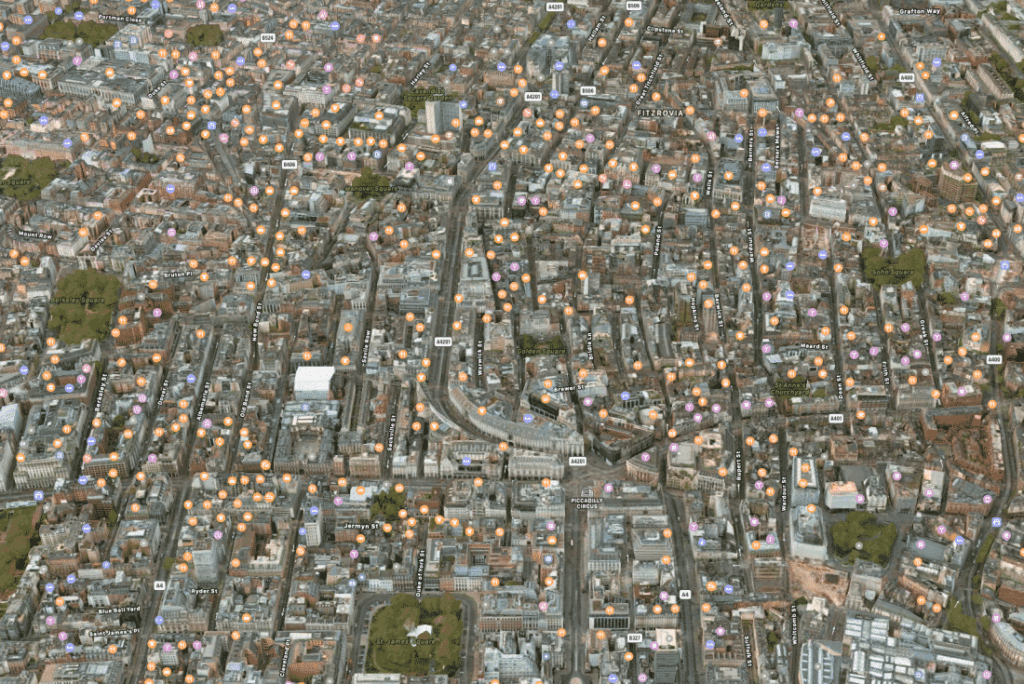There’s no doubt that the explosive rise in the number of smartphones has changed the world as we know it. The increased number of sensors and connected devices has produced mountains of data. This is being used to transform the way that we live our lives.
IoT, location data, location intelligence, big data. Whatever your name for it, it’s hard to dispute the potential across a variety of industries
It’s now apparent that granular location data can provide unprecedented insight into the offline world. More businesses are realising the value of mobile location data and the impact it is having across the globe.
As we move away from unreliable data sets, sensor-driven accurate data sets are taking centre stage. This kind of accurate data has many applications. But I’d like to look at some that are having the greatest disruptive impact.
Table of Contents
Business intelligence

The ability to notice trends by using data isn’t new. The ability to do this based on people’s activity in the offline world, in a close to real-time manner is.
Location intelligence reveals relationships between big data sets that often would be missed. It turns these insights into actionable business intelligence. Helping inform decisions, from the boardroom to the storefront.
From the small bar that is competing with huge chains of venues through to the small retailer competing with online mega corporations. These businesses are gaining valuable insights from using this kind of big data to inform their business strategy.
The truth is that mobile location data has now matured enough to solve many problems that both small business and enterprise face. Let’s look at a few:
Financial services – understanding footfall through big data sets is valuable for the financial sector. Mobile device data can help to forecast earnings and other KPIs before they are formally reported. This helps inform investment decisions.
Retail – big data can help both small and large retailers. Understanding store visits, as well as customer behaviour through mobile device data, is having many positive effects on the retail sector. These insights can help inform business decisions such as store layout, opening times, staffing and more.
Infrastructure and planning

We’ve all heard of the term smart city. We like to think that there’s more to it than just adding a few data points and putting the word smart in front of it. It is, in fact, more than that. We’re moving towards urban centres with huge populations and aspiring towards self-driving vehicles. Big data is the key to unlocking this truly smart future.
The rise in mobile device data has provided better opportunities to understand how cities work. It’s helping to create systems and infrastructure that reflects this.
Combined with the increasing number of connected devices in cities, central planning authorities now have a set of tools that can inform decision making in many different areas.
Mobile location data is contributing to a better understanding of where demand for public infrastructure is greatest. For example, examining mobile device location data to understand the most cycled roads within a city. This information is precise and invaluable when planning where to implement new routes.
The same is true of traffic and congestion. In increasingly crowded and polluted megacities, it’s important to understand how traffic issues can be alleviated. Understanding traffic flow and where to build new road structures, or introduce new low emission zones is crucial to building the kind of smart city that can sustain current levels of population growth.
Big data is having a huge positive effect on this kind of planning. Thanks to the accuracy and uniqueness of mobile device data and location intelligence, it is changing how decisions are made in cities and towns around the world.
Marketing and advertising

Big data and marketing have always complimented each other. Marketers have always looked to use data sets to improve the efficiency and effect of ads. Using big data to create tailored and relevant audiences is not a new practice.
But mobile location data allows marketers and advertisers to connect digital advertising to how consumers behave when they are offline. Understanding how consumers move in the offline world is helping marketers to become more effective. It’s assisting marketers in providing more personal advertising to consumers.
Location intelligence is disrupting many stages of the consumer lifecycle. It’s bringing the analytical capabilities that have been available for the web to the real world.
Segmentation
Mobile device data is helping to build up complex pictures of how people move and behave. This helps advertisers to build complex customer profiles. Brands are finally understanding the places that their customers go and how they interact with the physical world around them.
This is far more effective than other methods of audience segmentation. This is because a person’s location is often a much greater sign of intent than when they are searching for something on a computer, or browsing on their phone whilst sat on the couch.
This allows marketers to identify exactly where consumers are on the buyer journey. Moreover, it allows them to do this with a greater level of detail.
Personalisation
One big breakthrough that big data has had on marketing and advertising is by increasing the ability personalise at scale.
Location data is allowing brands to be helpful and human by understanding the situation of the customer. The concept isn’t new, but the accuracy and increasing size of data sets in the space have allowed commutation to really get personal.
Location help provide promotions at the moment when the customer can actually redeem it. It allows the ‘customers also bought’ experience to reach the real world retail store. In this way, big data is providing digital solutions to offline problems. Location intelligence is tailoring brand communications to a person’s unique experience of the real world.
Customer experience
Big data has changed customer experience for the better. Location intelligence can help to automate way-finding, ordering, assistance and queue management. Understanding the physical location of a person has helped improve the guest experience across many sectors.
Stadiums, resorts, airports, transport hubs all stand to improve the experience of the people who spend time and money in these places. It might be location based ticketing – you buy your ticket by walking onto a train. Or it may be ordering food and drink to your location.
There’s still huge scope for big data and location intelligence to be applied to improve the customer experience.
Attribution
Mobile device data as we have seen has connected many digital walks of life to offline consumer behaviour. Another way that this technology is revolutionising the marketing and advertising space is through attribution.
Traditionally many advertisers have been blind when it came to measuring the impact of offline ads on offline KPIs.
But the mobile device location data is filling in the blanks. Location intelligence can understand when a person is in front of, for example, OOH advertising. It can then measure how many of these people are then seen inside a store or in front of a specific physical product.
Connecting the two provides an accurate way for marketers to measure the impact and ROI of offline advertising inventory. it also allows them to measure the effect of digital advertising on an offline goal. These things have just not been possible with certainty before. But big data has changed the way that advertising can be measured.
AR
If AR is really going to live up to its promises, it will have to rely on complex data sets and accurate location intelligence.
As AR gains prominence it’s application will move beyond fun to play games to useful productivity applications (you can even combine it with some powerful notion templates to really level up). As AR develops, it’s used as a way of reaching audiences with content and advertising will grow. Like previous marketing activity, it will be improved by the use of big data and location intelligence.
AR will require huge amounts of accurate and real-time location data to function properly as a user moves around the real world.
Optimising the supply chain

Big data and location intelligence is impacting organisations that want to optimise the supply chain.
The obvious application of location intelligence in the retail supply chain lies in the ability to understand and track deliveries and supplies. It already being used to generate data sets which can optimise and improve these services.
But location intelligence isn’t just helping business to optimise the process. It’s helping to understand the demand for products. There’s a lot of history of people building something in the hope that people want it to then find out that actually, they don’t.
Another way that big data is helping manufacturing industry to optimise is by helping it to adjust the type of transportation, pickup location or place of sale.
With the rise of location data, these insights are now fuelled by information from the offline world. Insights that have previously been unattainable or have lagged are now available in real-time. This lies at the heart of what is disrupting how the supply chain operates.
Privacy and transparency
As usual with new disrupting activity, the focus in on the responsibility of these new technologies. And rightly so. Indeed those in the big data space will need to be more transparent in how data sets are sourced.
It won’t be enough to simply check a box and start collecting and aggregating personal data. More needs to be done in order to clean up the data supply chain. More control needs to be handed to the user.
In this way, it’s our responsibility to communicate the value of big data and location intelligence to the user. It’s having a huge positive impact across the globe, and that’s just more reason to get the privacy part right.
Learn more about big data
James is the head of marketing at Tamoco



Leave a Reply